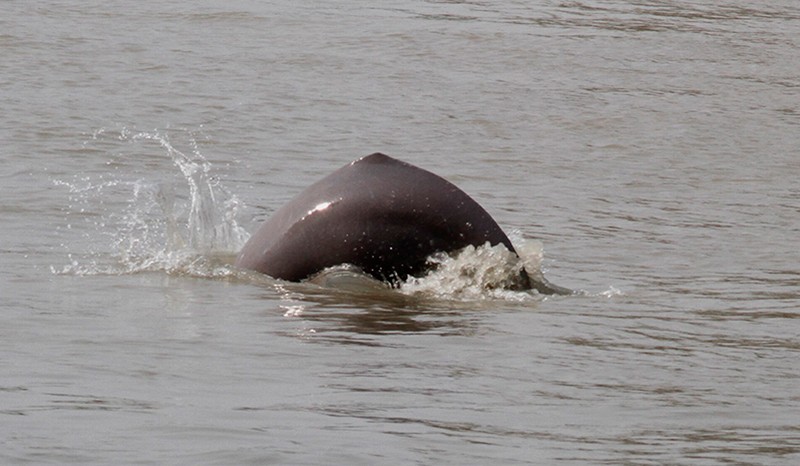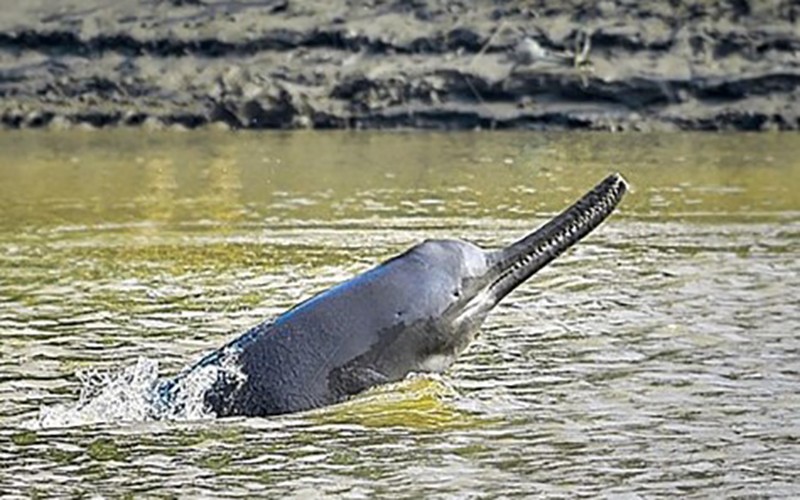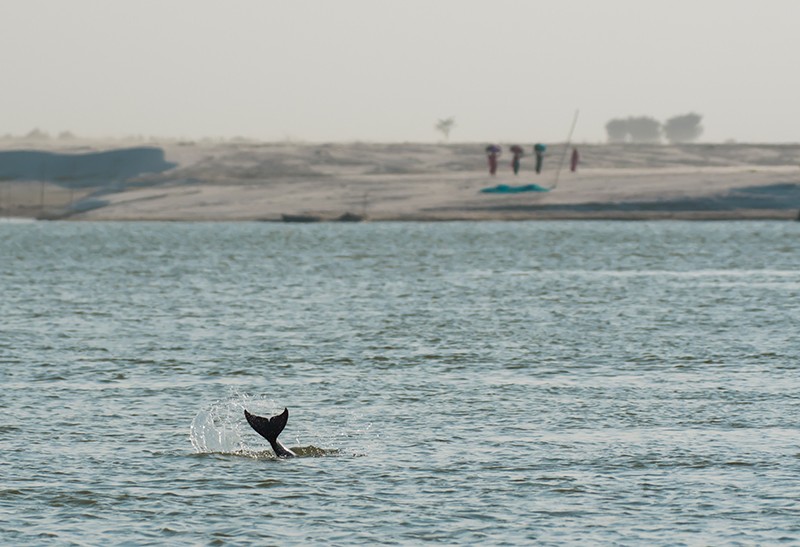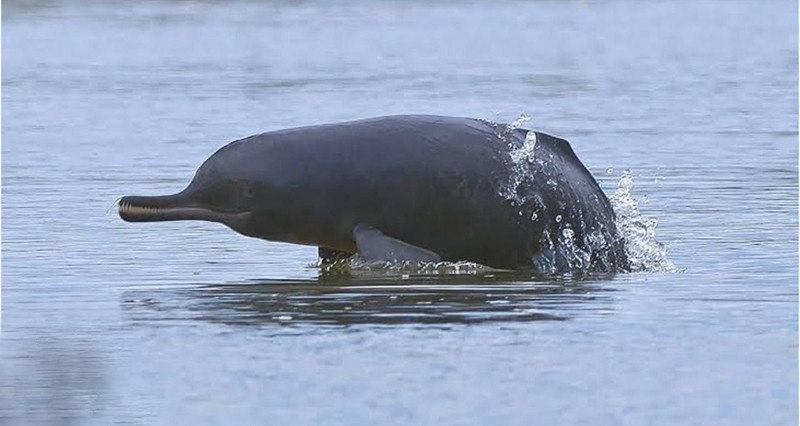India's River Dolphin: Clear And Present Danger
The lovable river dolphin of India is in danger of survival and needs urgent conservation efforts as the first ever survey on the species published recently reveal, writes Ranjita Biswas
When we were young and the Brahmaputra Bridge (the first one) was yet to be built, the greatest joy for us was to watch the numerous dolphins jumping up and down as our ferry progressed from Silghat on the south bank of the river to Tezpur on the north bank. Going to Tezpur in autumn was an annual affair as Durga puja was performed at our ancestral home.
Much water has flowed down the mighty Brahmaputra and there are now a couple of bridges over it. But meanwhile the dolphins have depleted in huge numbers. Local people who still take boats and ferries to some operating ghats say they rarely see any dolphin, called shihu in local language, in the water.
The first-ever comprehensive survey of river dolphins published recently revealed that an estimated population of 6,327 dolphins are found mainly in the Ganga, Brahmaputra and Indus River basins.
The survey, conducted under Project Dolphin launched in 2020, gives the first-ever glimpse into the species’ status in India. The survey covered 8,507 km of river systems across 28 rivers in eight states.
 Dolphin in Sundarbans. Photo: Wikipedia
Dolphin in Sundarbans. Photo: Wikipedia
Assam recorded 635 dolphins during the survey. Most of the dolphins — estimated to be 6,327— were observed in Uttar Pradesh (2,397), followed by Bihar (2,220) and West Bengal (815). Jharkhand recorded 162 while Rajasthan and Madhya Pradesh registered 95. Punjab recorded the lowest, with three dolphins.
Says Abdul Wakid, long associated with dolphin research, and involved in the current survey, “In Assam, river Subansiri in upper Assam and Kulsi in lower Assam, tributaries of the Brahmaputra, have long been known as residential population areas of the dolphin. But this survey has also recorded two new residential populations in the Kapili river near Nagaon and Beki near Barpeta. We found none, however, in the Barak River in the south.”
He also shared that the stretch of the Brahmaputra near the Kaziranga National Park is a ‘hotspot’ of concentration of dolphins. One may wonder if the absence of human activities near protected areas like fishing has something to do with it.
India is home to two species of freshwater dolphins — Ganges (Platanista gangetica) and Indus (Platanista minor), which serve as bio-indicators of healthy river ecosystems. Both species are classified as Endangered and listed as Schedule I being under the provisions of the Wild Life (Protection) Act, 1972.
Generally, the species prefer confluences, meanders and mid-channel islands. Scientists say that the dolphins act as an umbrella species and their conservation has direct impacts on their habitat and biodiversity.
The report states that the number of Ganges river dolphins at the end of the 20th century were estimated to be around 4,000-5,000 but dropped to about 1,800 recently.
The Gangetic dolphin is the national aquatic animal of India. The Vikramshila Gangetic Dolphin Sanctuary in Bihar’s Bhagalpur district , spread over 60 kilometers, is the only one of its kind in the country till now.
 Ganga River Dolphin. Photo: Wikipedia
Ganga River Dolphin. Photo: Wikipedia
The threats
According to a report by the ‘riverdolphins.org’ (Dolphins, Threats and Best Practices for Conservation, 2021), dolphin oil is traditionally in great demand as it is used for medicine believed to cure rheumatism, nervous disorders, asthma and even, as an aphrodisiac.
Bait fishing i.e. the use of the oil to catch catfish is an age-old practice in India’s Ganga and Brahmaputra river systems. Then there are frequent incidents of net entanglement as well.
The accidental entanglement in fishing gear and manmade capture of Ganges river dolphin is one of the major threats impacting the species in the river ecosystem.
“Net entanglement causes much more than just direct injury or mortality to the species. Limited studies have been carried out in the Ganges river dolphin in the context of using acoustic deterrents to prevent dolphin bycatch in nets which is an important step towards conservation of this species,” the report says.
 Dolphin in Vikramshila Gangetic Dolphin Sanctuary. Photo: Wikipedia
Dolphin in Vikramshila Gangetic Dolphin Sanctuary. Photo: Wikipedia
Why is ‘acoustic deterrents’ necessary? Because the Gangetic dolphin is almost completely blind. Scientists say that evolving in silty, murky environs for over 30 million years, it has all but lost its eyesight. Its eyes are very small and unlike ocean dolphins, have no lenses. It lives by echolocation and sound is everything to this most ancient of all cetaceans.
It is not that the fishermen are unaware of the dangers to the shushuk but economic constraints and being without an alternative to a livelihood, they continue in their age-old practices. As the report observes: “In our surveys, 86% of the respondents encountered or have had a personal experience relating to dolphins in their lifetime.
It was evident that many fishermen were aware that using river dolphin oil was illegal but were actively involved in bait oil fishery using dolphin oil. Additionally, of the fishermen who had experienced entanglement of dolphin in fishing nets, 57.8% admitted to selling the carcass for oil.
An overwhelming percent of the oil bait fishermen (of the 64.6% involved in bait fishing) responded that they are willing to leave this occupation if better alternatives are available. Overall fishing was perceived as a trade with uncertain income and high risk, and many of the respondents expressed desire for shifting to alternative trade.”
A ‘Conservation India’ report adds that “…the loss and fragmentation of riverine habitat and changes in water flow, due to the construction of dams and irrigation projects has become an immediate problem,” for the survival of the species which inhabit waterways in one of the most densely populated areas in the world.
 Brahmaputra Dolphin / Photo: Udayan Borthaku
Brahmaputra Dolphin / Photo: Udayan Borthaku
To preserve this endangered species, efforts are needed on many fronts, including human intervention and awareness campaigns.
The ‘Project Dolphin’ was initiated in 2021 by the Ministry of Environment, Forest and Climate Change.
Meanwhile, a Comprehensive Action Plan (2022-2047) has been finalised and shared with relevant Ministries for execution. The Wild Life (Protection) Act, 1972 was amended in December 2022, empowering the Indian Coast Guard with enforcement powers and recognising Gangetic and Indus River Dolphins as distinct species under Schedule I.
IBNS
Senior Staff Reporter at Northeast Herald, covering news from Tripura and Northeast India.
Related Articles

UN issues dire warning: Asia faces rising cyclones and flooding like never before
Across southeast Asia, record-breaking rains and flooding caused by back-to-back tropical storms have claimed hundreds of lives and brought devastation and displacement upon entire communities, UN agencies said on Tuesday.

Hidden mental health cost of birth control pills? Study finds shocking link
A new study has suggested that the use of contraceptive pills may have a hidden cost: impaired mental health.

Stunning drop! India reports 49% fall in annual new HIV cases
The Indian government has announced that the country recorded a nearly 49 per cent decline in annual new HIV infections between 2010 and 2024.

WHO describes obesity as a 'chronic disease', backs wider use of weight-loss medicines
The UN World Health Organization (WHO) has issued its first guideline on the use of a new class of weight-loss medicines, marking a significant shift in global health policy as obesity rates continue to rise.
Latest News

Prime Minister Mark Carney to attend FIFA World Cup 2026 Final Draw in Washington

Germany arrests two Iraqi nationals over suspected Islamic State links

Spanish tourist stabbed at Berlin Holocaust Memorial testifies in terror trial

Madras HC slams TN Govt for 'wilful disobedience' after Karthigai Deepam not lit at ancient pillar

